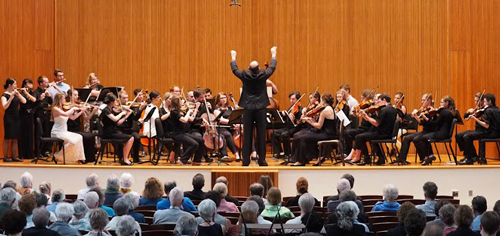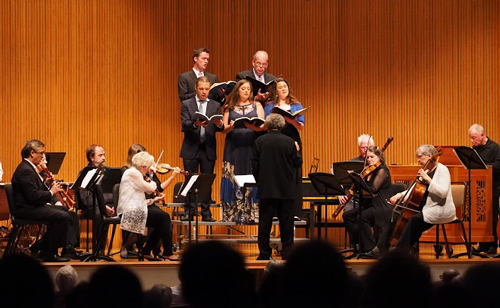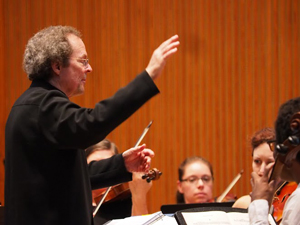by Daniel Hathaway

That concert, given in support of a medical institute for the poor, began with what seems to have been the first ever performance of the Credo from Johann Sebastian Bach’s Mass in b minor. C.P.E. Bach provided the Credo with a brief, new introduction and slightly adapted it to a new age when instruments like the oboe d’amore had become obsolete and needed to be replaced (in this case by violins). Bach’s concert continued with Ich weiß, daß mein Erlöser lebet and the Hallelujah chorus from Handel’s Messiah, and after a pause, three of C.P.E. Bach’s own compositions — a sinfonia, the Magnificat and his double-chorus Heilig.
Invoking the spirit of that occasion but adapting it to the situation at hand, Slowik began Friday evening’s performance with three sinfonias or symphonies by “The Bach Boys” — Wilhelm Friedemann’s two-movement Sinfonia in d (played by the BPI student orchestra directed by Joe Gascho), Johann Christian’s Symphony in g, op. 6, no. 6, and Carl Philipp Emanuel’s Symphony à 12 in D, Wq 183, the last two played by the BPI faculty orchestra, actually a combination of faculty and advanced students, conducted by Kenneth Slowik.
Wilhelm Friedemann (1710-1784) tipped a hat to his father in the form of an energetic fugue that followed a swooning introduction. Johann Christian (1735-1782) delivered a more dramatic product, full of dynamic and emotional contrasts. Carl Philipp Emanuel (1714-1788) played wittily with an opening gesture involving three repeated notes and their related triads, advanced to an expressive Largo and brought the energetic final Presto to a surprising ending.
As might be expected at the end of only two weeks, the all-student orchestra of flutes and strings sounded brave but tentative. Led by the pros, the combination faculty-student ensemble dug into the music with confidence and a fine sense of style.
Nobody knows why a good Lutheran cantor assembled a full Catholic mass late in his career, but Johann Sebastian Bach’s B Minor Mass has become one of the monuments of Western music. The Symbolum Nicenum or Credo makes an effective stand-alone piece, having been one of the four bundles into which Bach divided the manuscript, and containing perhaps the latest music he wrote for the extended work (there are only a few sections that rework earlier music, including the Crucifixus, from the very early cantata BWV 12, and the Et expecto from BWV 120).
For this performance of Credo, Slowik adopted the one singer, one player on a part format that Joshua Rifkin proposed in a paper to the American Musicological Society in 1981, causing such a seismic disruption that the session dissolved in chaos. Thirty-three years later (and following Rifkin’s own 1981 recording of the B Minor Mass using solo singers and instrumentalists), it’s difficult to imagine what all the fuss was about.
C.P.E. Bach’s 28-bar introduction was unmemorable. What followed was a complete delight. A superb quintet of singers stacked up high on a riser — sopranos Teresa Wakim and Sandra Simon, alto Daniel Taylor, tenor Aaron Sheehan and Oberlin Conservatory faculty bass Timothy LeFebvre — sang both the “chorus” parts and arias and duets with consummate skill. The orchestra, headed up by concertmaster and Oberlin violin professor Marilyn McDonald, played with polished transparency, and the trio of baroque trumpets negotiated stratospheric lines with apparent ease.
Even in such a consistently fine performance, there were high points. Timothy LeFebvre’s Et in Spiritum Sanctum tripped along handsomely in 6/8 time with violins ably filling in for the two oboi d’amore. The transition from Crucifixus (with Bach’s masterful, last-minute modulation into G Major) to Et resurrexit was hair-raising. The ensuing vocal melismas were crystal-clear even at Slowik’s brisk tempo, and the orchestral postlude was so infectiously cheerful that you wanted to applaud then and there.
More instrumentalists and a pickup chorus filled the stage for the finale, Handel’s Hallelujah Chorus, already internationally famous in 1786 and prefaced by Slowik’s injunction to the audience, “If you need to sing along, please do so in German.” A charming way to end the evening. Refreshingly, the audience remained seated both for the chorus and the warm ovation that followed.
Photos by Dale Preston courtesy of the Oberlin Conservatory of Music.
Published on ClevelandClassical.com July 1, 2014.
Click here for a printable copy of this article.






